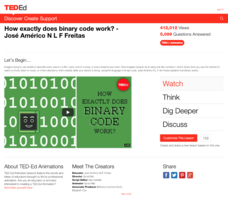Lesson Planet
EdTech Tuesday: Risk-Taking in the Classroom with Bill Selak
Interested in using technology in the classroom but worried about the risks involved? Listen as Bill Selak, a fourth-grade music teacher, describes his experiences integrating technology in the classroom and the positive impact of...
Real Engineering
Designing the Fastest Wheels in History
Record-setting cars need specially made tires. Young engineers watch a video in the Real Engineering series to learn about designing tires. Along the way, they study acceleration, inertia, and angular velocity.
Curated OER
Editing Music in Audacity
Make your podcast perfect by editing the music you choose. Part seven focuses on music editing.
Curated OER
5 Importing Music in Audacity
Importing music to accompany your podcast is the topic of part five of this nine-part series. Jill explains how and where to get music, how to use it, and how it works in the Audacity software. Your class podcast will be really great now!
Real Engineering
Why Are I-Beams Shaped Like an I?
There's a reason why they're called I-beams. A short Real Engineering video describes why I-beams are in the shape of an I. It considers how the beam achieves maximum bending load with the least amount of material.
Common Sense Media
What Is Digital Citizenship?
Spark scholars' interest in becoming a super digital citizen with a brief, yet informative video that details what digital citizenship is and why it's important.
Code.org
How Computers Work: Binary and Data
There are two types of people in the world: those who understand binary and those who do not. Pupils watch a video that describes how computers store information using binary code. They learn how programmers can encode text, images, and...
Get Chemistry Help
Chemistry Lesson: Acid-Base Neutralization Reactions
Provide your emerging chemists with the most descriptive way to perform specialized double displacement reactions possible! This video details acid-base neutralization, where acids and bases are combined to result in salt and water...
Crash Course
The First Movie Camera
The second episode in a playlist on the history of film focuses on the role the Kinetograph and the Kinetoscope played in film history. The video also includes information about the contributions of scientists, Vaudeville performers, and...
Crash Course
AI Playing Games: Crash Course AI #12
Can AI beat humans at tic-tac-toe? The 12th episode in the Crash Course Artificial Intelligence series focuses on teaching computers how to play games. Scholars learn about historical attempts to teach checkers and chess, and see how the...
Physics Girl
Everything You Should Know about Trappist-1 Exoplanets
Have we found the next Earth? Join the host of an interesting physics series as she learns what scientists know about the planets orbiting the star Trappist-1 during an engaging video. Astronomers discuss how they located the system,...
Crash Course
The Medieval Islamicate World: Crash Course History of Science #7
The Medieval Islamicate World was truly a world of wonders! Clocks with gears, armillary spheres ... and robots that played music? Journey to ancient Baghdad, the center of science and math with the seventh video in a History of Science...
TED-Ed
The Train Heist | Think Like A Coder, Ep 4
Robots come in handy when planning a train heist. The hero and her robot continue their quest to find artifacts to save the world. They must locate and steal the Node of Power on a specific car of a train by writing computer code for the...
TED-Ed
The Physics of Playing Guitar
Everyone knows that guitar music rocks - but why? And how? Learn about the ways a single pluck can create sounds that resonate from string, to ear, to soul with a fascinating video about the physics of sound vibration.
Physics Girl
Could You Replace Your Eye with a Camera?
Eyeballs or cameras—which have the best functions? The video presentations compare the important functions of the eyeball and the camera. As technology changes, cameras become more impressive, but the eyeball still out-functions the...
Crash Course
2001 - A Space Odyssey: Crash Course Film Criticism
Will the advancement of technology doom interpersonal relationships? Like the score for Jaws, the music for the opening sequence of Stanley Kubrick's 2001- A Space Odyssey stirs the imagination of viewers. Cinema lovers and film...
American Chemical Society
What Makes Rubber Rubbery?
Surprise! A pigskin isn't actually made from pig skin. Scholars learn about the properties and uses of both natural and synthetic rubber by watching a video in the ACS Reactions series. In particular, the video focuses on the different...
Crash Course
Let's Make an AI That Destroys Video Games: Crash Course AI #13
Now that we've made a video game, we might as well figure out how to beat it. Scholars create simple video games and then program an AI to defeat them in the 13th installment of the Crash Course Artificial Intelligence series. They...
Crash Course
Economic Schools of Thought
Adam Smith, Karl Marx, and John Maynard Keynes held different beliefs about economic systems that evolved from their predecessors, and then shaped by their countries' economic situations. A video from Crash Course Economics...
Science Today
Earth at Night
The Sumoi NPP satellite collects light from Earth's surface during nighttime hours. From the images produced, scientists can study populations, pollution, sea ice, moon phases, and more! This brief video clip would be a high-quality...
Physics Girl
Are MRIs Safe?
We know about radiation from airplanes, and x-rays, but are MRIs considered safe? An informative video offers an simplified overview of how an MRI works. Then a comparison between MRIs and fMRIs opens new understanding. Finally it...
TED-Ed
How Does Your Smartphone Know Your Location?
When your smartphone tells you the weather of your current location or gives you directions to the nearest gas station, there's more going on that you might realize. Follow along with this short video as it explains how...
TED-Ed
How Exactly Does Binary Code Work?
As far as languages go, binary is pretty easy to learn. Scholars watch an informative video on binary code. It explains the basics of how binary code works, and then shows how people encode colors and sound as binary code.
American Chemical Society
How Is Leather Made?
Leather tanning is a chemical production! Scholars watch as a video outlines the chemistry behind processing leather. The instructor describes the chemical makeup of the leather itself and the structure of the chemicals that preserve the...























